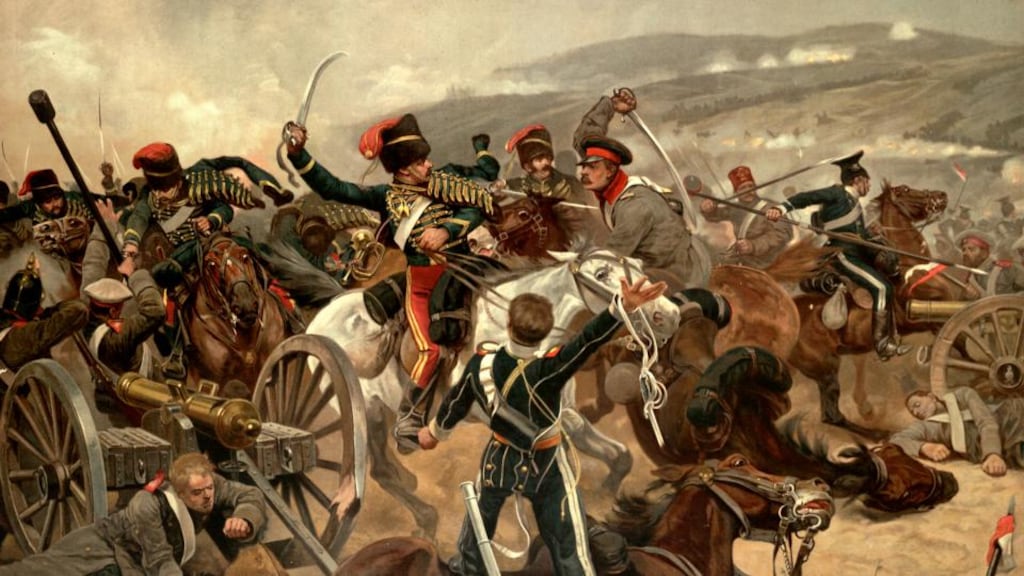The Charge of the Light Brigade has gone down in history as an outstanding example both of soldiers' courage and officers' incompetence. Tennyson's famous poem concentrated on the courage. The incompetence was summed up by an astonished French marshal who, witnessing the spectacle, commented: "C'est magnifique, mais ce n'est pas la guerre".
Between these two extremes, however, is an interesting Irish story concerning the musical accompaniment to the debacle. Because after the confused orders, and before the charge, there had to be a bugle call, or a series of them. And it’s a little-remembered fact now that both the “Bugle of Balaclava” (as it became known) and the bugler were from Dublin. The former was made in the Capel Street shop of John McNeill, whose name is still on the instrument. The man who blew it was William “Billy” Brittain, trumpeter to Lord Cardigan and one of the 17 per cent of participants in the charge who were Irish.
There is still some debate as to whether Brittain actually did get around to sounding the charge, or whether the cavalry jumped the gun after the initial signals to “walk”, “trot”, and “gallop”.
Unfortunately, he wasn’t around long to clarify the matter for historians. Having survived the Russian artillery, albeit wounded, he succumbed to another hazard of the Crimean war, Florence Nightingale’s notoriously unhygienic hospital in Istanbul.
The bugle, which the plucky Dubliner hung on to even when he fell, was also badly injured, when a Russian on horseback tried to pick it up with his lance and punched a hole in it. Happily, it survived to go home with the other war-wounded. But alas, it was lost to Dublin eventually. After changing ownership a few times, it’s now in a regimental museum in England.
McNeill’s music shop survived for more than a century in Capel Street and was revived in recent times, over a pub of the same name, only to close again a few years ago. The good news is that the pub survives and preserves a link with its heritage by hosting regular music sessions. Trumpeters be warned, however – the music is of the traditional Irish kind, or sometimes bluegrass. You’re advised against turning up with a bugle.
It’s a quirk of history that the glorious disaster of the Light Brigade has so overshadowed the Charge of the Heavy Brigade, which happened earlier the same day, had even more Irish involvement (including a horse called Dickie Bird, whose skeleton can be seen in the National Museum at Collins Barracks), and was a success.
A more rational legacy of the Crimean war is the number of words it bequeathed to the English language for articles of clothing. The shores of the Black Sea must have been a very cold place in winter, given the importance of the Cardigan (named after the aforementioned Lord), the Raglan, (a type of overcoat named for another of the officers), and of course the Balaclava.
I was reminded of this legacy in another Dublin pub recently, one also synonymous with traditional music, the Cobblestone on Smithfield Square. In fact, the Cobblestone has claims to be the pre-eminent Dublin trad pub, with sessions every day or night of the week. And based on a recent visit there, I wouldn’t disagree.
It was a Monday, when even in August, you’d expect things to be quiet. Instead, the place was full. And I counted no fewer that 14 musicians giving it welly in their allocated corner. You could see why the venue is so popular with instrumentalists, because whereas in other Dublin venues they might be mere background noise, here they’re on a pedestal. As numerous as the session participants were, they were almost outnumbered by signs reminding customers that this was a “listening area” and warning them to “respect the musicians”.
It’s a trad sanctuary, clearly – doing for fiddlers, whistle players, and pipers what the Blessington Street Basin does for birds. But of course there can be a certain amount of pressure in playing to such rapt audiences. So among the events hosted in the Cobblestone, I noticed, is something called the “Balaclavas Session”, held every Wednesday in the back room.
No, participants don’t wear actual balaclavas– that’s the pub’s little joke. It’s just that the back room provides a collective mask for shy or learning players until they acquire the courage to perform in the front bar. As in McNeill’s, however, you won’t hear any bugles in the Cobblestone, not even during the Balaclavas session. And as the Light Brigade might have told you, that’s no bad thing.
@FrankmcnallyIT











